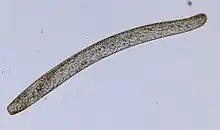Spirostomum
| Spirostomum | |
|---|---|
 | |
| Spirostomum ambiguum | |
| Scientific classification | |
| Clade: | SAR |
| Infrakingdom: | Alveolata |
| Phylum: | Ciliophora |
| Class: | Heterotrichea |
| Family: | Spirostomidae |
| Genus: | Spirostomum Ehrenberg, 1833 |
| Species | |
|
Spirostomum ambiguum | |
Spirostomum is a genus of free-living ciliate protists, belonging to the class Heterotrichea. Species of Spirostomum are found in both salt and fresh water. All are elongated, flexible and highly contractile. Although unicellular, members of some species can grow as long as 4 mm (0.16 in).[1]
Appearance and characteristics
.jpg.webp)
The body of the cell is long and worm-like. In cross section it is mainly cylindrical, but may be flattened at the tail end. The posterior excretory vacuole is large, and may fill the whole "tail." Cilia on the cell body are short and arranged in longitudinal rows. The length of the peristome varies between species, from about 1/4 to as much as 2/3 the length of the cell. The peristome is fringed with membranelles, which are used to channel particles of food into the creature's oral cavity. The macronucleus may be moniliform (like a string of beads) or compact and oval, depending on the species.[2]
Spirostomum reproduces by binary fission. Reproduction may be purely asexual, or it may follow conjugation, during which compatible mating individuals come together and transfer genetic material across a cytoplasmic link.
Members of the genus are extremely contractile. When startled, Spirostomum ambiguum can contract its body length by more than 60% within a few milliseconds (a contraction speed similar to that of the ciliate Vorticella).[3][4][5] As it contracts, the cortex of the cell twists and widens, and its spiral structure becomes visible. The mechanism of Spirostomum's contractility was first studied by Ernst Haeckel in 1873 and has continued to attract scholarly attention.[6][7][8]
One widely distributed but rarely seen species, S. semivirescens, appears bright green due to being packed with endosymbiotic algae that are closely related to the genus Chlorella[9] (see zoochlorella) and houses itself within a mucilaginous lorica.[10]
Certain species have proven to be sensitive to the presence of heavy metals, and have been used by ecologists as indicators of water purity.[11][12]
Classification
The genus Spirostomum was established by Christian Gottfried Ehrenberg in 1833, and placed in the family Spirostomidae by Samuel Friedrich von Stein in 1867.
Recent analyses of ribosomal RNA gene sequences have confirmed that it is a monophyletic group.[13][14]
Communication
Spirostomum ambiguum communicates with its neighbours organisms by transmitting and then relaying turbulent signals between organisms, possibly as a defence mechanism against predators.[15]
Photo gallery
 Spirostomum ambiguum
Spirostomum ambiguum Spirostomum macronucleus
Spirostomum macronucleus Spirostomum teres still
Spirostomum teres still.jpg.webp) Spirostomum teres - 160x
Spirostomum teres - 160x.jpg.webp) Spirostomum teres - 160x
Spirostomum teres - 160x
Video gallery
- Spirostomum minus
- Spirostomum cell division (binary fission)
- Spirostomum caudatum (contraction)
- Spirostomum teres
References
- ↑ Lynn, Denis H. (2008). "Subphylum 1. POSTCILIODESMATOPHORA: Class 2. HETEROTRICHEA – Once Close to the Top". The Ciliated Protozoa: Characterization, Classification, and Guide to the Literature (3rd ed.). Springer. pp. 129–39. doi:10.1007/978-1-4020-8239-9_6. ISBN 978-1-4020-8238-2.
- ↑ Kudo, Richard (1954). "Family 3 Spirostomidae Kent". Protozoology (4th ed.). Charles C. Thomas. pp. 801–6.
- ↑ "World's Fastest Creature may Also be one of the Smallest".
- ↑ Ishida, Hideki; Shigenaka, Yoshinobu (1988). "Cell model contraction in the ciliate spirostomum". Cell Motility and the Cytoskeleton. 9 (3): 278–82. doi:10.1002/cm.970090310.
- ↑ Hawkes, R. B.; Holberton, D. V. (1974). "Myonemal contraction of Spirostomum I. Kinetics of contraction and relaxation". Journal of Cellular Physiology. 84 (2): 225–35. doi:10.1002/jcp.1040840209.
- ↑ Yagiu, Ryozo; Shigenaka, Yoshinobu (1963). "Electron Microscopy of the Longitudinal Fibrillar Bundle and the Contractile Fibrillar System in Spirostomum ambiguum". The Journal of Eukaryotic Microbiology. 10 (3): 364–9. doi:10.1111/j.1550-7408.1963.tb01689.x.
- ↑ Jones, Alick R.; Jahn, Theodore L.; Fonseca, James R. (1966). "Contraction of protoplasm. I. Cinematographic analysis of the anodally stimulated contraction of spirostomum ambiguum". Journal of Cellular Physiology. 68 (2): 127–33. doi:10.1002/jcp.1040680207. PMID 4960542.
- ↑ Lehman, William J.; Rebhun, Lionel I. (1971). "The structural elements responsible for contraction in the ciliate Spirostomum". Protoplasma. 72 (2–3): 153–78. doi:10.1007/BF01279048. PMID 5555985.
- ↑ Hines, Hunter N.; Onsbring, Henning; Ettema, Thijs J.G.; Esteban, Genoveva F. (December 2018). "Molecular Investigation of the Ciliate Spirostomum semivirescens, with First Transcriptome and New Geographical Records". Protist. 169 (6): 875–886. doi:10.1016/j.protis.2018.08.001.
- ↑ Esteban, Genoveva F.; Bradley, Mark W.; Finlay, Bland J. (2009). "A case-building Spirostomum (Ciliophora, Heterotrichida) with zoochlorellae". European Journal of Protistology. 45 (2): 156–8. doi:10.1016/j.ejop.2009.01.002. PMID 19264465.
- ↑ Nałęcz-Jawecki, Grzegorz (2004). "Spirotox—Spirostomum ambiguum acute toxicity test—10 years of experience". Environmental Toxicology. 19 (4): 359–64. doi:10.1002/tox.20023. PMID 15269908.
- ↑ Madoni, P (2000). "The acute toxicity of nickel to freshwater ciliates". Environmental Pollution. 109 (1): 53–9. doi:10.1016/S0269-7491(99)00226-2. PMID 15092912.
- ↑ Schmidt, Stephanie L.; Foissner, Wilhelm; Schlegel, Martin; Bernhard, Detlef (2007). "Molecular Phylogeny of the Heterotrichea (Ciliophora, Postciliodesmatophora) Based on Small Subunit rRNA Gene Sequences". The Journal of Eukaryotic Microbiology. 54 (4): 358–63. doi:10.1111/j.1550-7408.2007.00269.x. PMID 17669161.
- ↑ Miao, Miao; Song, Weibo; Clamp, John C.; Al-Rasheid, Khaled A.S.; Al-Khedhairy, Abdulaziz A.; Al-Arifi, Saud (2009). "Further Consideration of the Phylogeny of Some "Traditional" Heterotrichs (Protista, Ciliophora) of Uncertain Affinities, Based on New Sequences of the Small Subunit rRNA Gene". Journal of Eukaryotic Microbiology. 56 (3): 244–50. doi:10.1111/j.1550-7408.2009.00391.x. PMID 19527351.
- ↑ Rachel Berkowitz, A tiny swimmer generates rapid, far-reaching signals in water, Physics Today, Sep 2019, pp22-23.